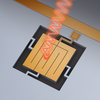The Quantum Calorimeter Group in the Quantum Sensors Division develops and applies sensors that detect the energy of single photons and particles. These devices are typically fabricated from superconducting materials and achieve unprecedented energy sensitivity by leveraging certain unique properties of quantum mechanics and superconductivity. For example, Transition-Edge Sensors (TESs) are able to measure the energy of single x-ray and gamma-ray photons with a precision better than one part per thousand and Thermal Kinetic Inductance Detectors (TKIDs) are able to measure the energy of charged particles over several orders of magnitude with similar precision.
The group also develops complete spectroscopic measurement systems based on arrays of these superconducting microcalorimeter sensors. Working closely with the Quantum Electronics and Device Fabrication groups, the team develops custom multiplexed readout, cryogenics, x-ray windowing, acquisition and analysis software to enable arrays of hundreds to thousands of microcalorimeter pixels in a deployable instrument. These x-ray and gamma-ray spectrometers combine good spectral resolving power and good collecting efficiency in a way that is not possible with other detector technologies, enabling new measurement modalities. Our microcalorimeter spectrometers are being implemented in experiments at synchrotron beamlines, particle accelerators, nuclear analysis labs, table-top x-ray systems, and suborbital balloons. These detectors are providing new measurement capability for a wide range of applications including materials analysis, quantum information, astrophysics, microelectronics defect analysis and supply chain verification, and the accumulation of atomic and nuclear reference data for industry and nuclear security.
News and Updates
Projects and Programs
Publications
Awards
Patents
Contacts
Group Leader
-
(303) 497-3389









